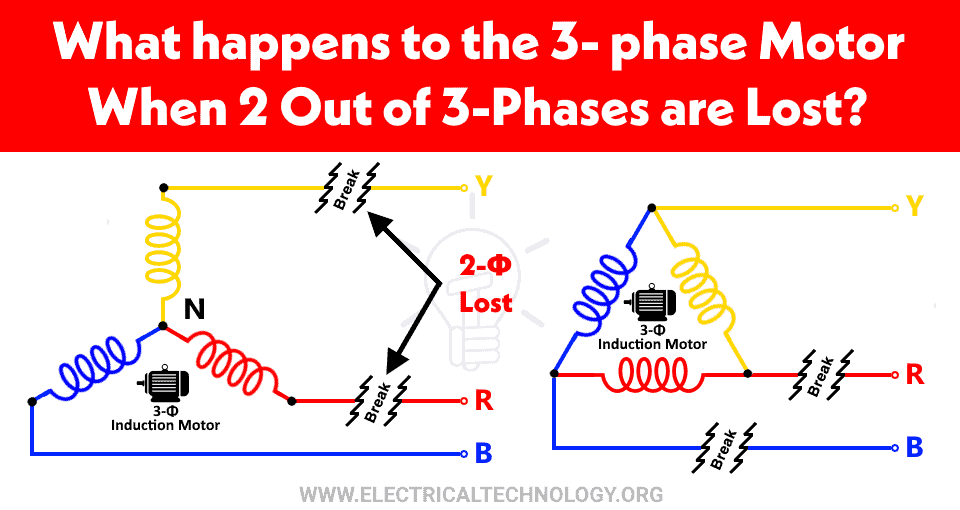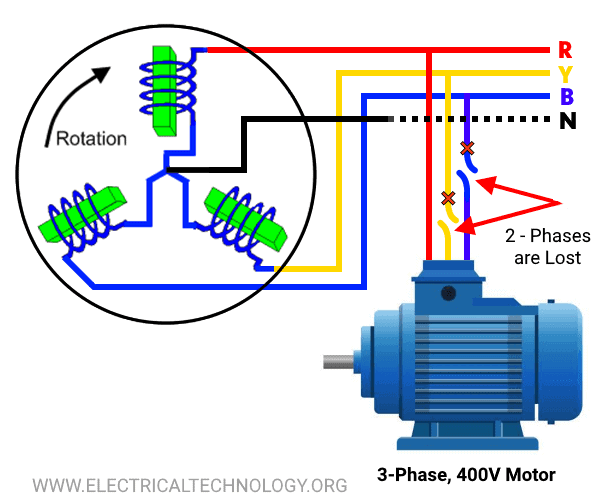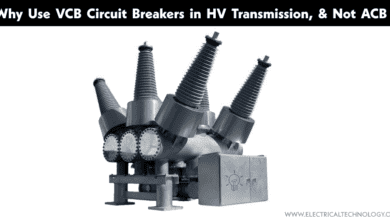What happens to the 3-Phase Motor When 2 Out of 3 Phases are Lost?
What will happen to the 3-Φ Induction Motor Incase of Failure of 2 of the 3-Phases?
When a linear or balanced load is connected to the 3-Φ supply system, the sum of the instantaneous currents of all the three lines (phases) is 0. Alternatively, the magnitude of flowing current in one line (phase) is equal to the sum of the currents in other (remaining) two lines or phases but in opposite directions. To the point, in a three phase system, the return path for the current in any phase line is the other two phase lines. In very short, each of the three phases serve as a “return path” for the other of the remaining two phases.
In case of three phase induction motor, only three phase lines are connected to the motor either in Star or Delta configuration e.g. all the three phase conductors are needed to run the motors as all of them are needed to complete the circuit. But what if one or two of the phases are disconnected to the three phase induction motor?
It is a different (as well as dangerous) scenario when one of the phases is disconnected to the running three phase induction motor and we have already discussed that case in our previous post in very detail. For motion, it is needed at least two phases for any current to flow in the wye or star (Y) connection or delta connection. In today’s post, we will discuss what will happen if two out of three phases are lost to the three phase induction motor.
Related Posts:
- What happens to the 3-Phase Motor When 1 Out of 3 Phases is Lost?
- What happens if You Connect a 3-Φ Induction Motor to 1-Phase Supply?
- How to Run a Three-Phase Induction Motor on a Single-Phase Power Supply?
What will happen if Two of the Three Lines of Three-Phase Induction Motor are Opened?
In short, the spinney thing will no longer do spinney thing.
As discussed above, all the three phases are needed to complete the circuit in a three phase induction motor where it is needed to produce a rotating magnetic field and uniform torque. When two of the phases are lost or broken due to some faults or blow fuses, the circuit acts like an open circuit.
In this situation, there is no return path for the current to flow in the stator winding. So no current flows at all. As only one phase is connected to the motor, the circuit is not like a single phase supply system (or operate as single phase induction motor) as there is a neutral wire for the returning current to complete the circuit.
So this is the same case like a Neutral or Phase is broken in a single phase supply system. When only one phase is connected to the 3-phase induction motor, nothing happen i.e. no damage or burning the motor expect:
- If the motor is running = It will stop immediately (due to open circuit)
- If the Motor is Stopped = The motor won’t start at all (due to the absence of current as well as RMF).
In short, the circuit is incomplete in case of two phase failure out of three, so there will be no current, no phase shift, no flux, no RMF & torque and finally NO MOTION at all.
Related Posts:
- Difference Between Single Phase & Three Phase Induction Motor
- Difference Between Single Phase and Three Phase Power Supply
Concluded Points:
When two phases are lost the motor is as dead as if there is no electric power at all. So that,
- 3 Phases Available: Motor runs
- 2 Phases Available : Motor runs in a bad way and draws LRA (Running-Load-Amps) and trips the circuit breaker or burns up.
- 1 Phase Available: If the motor is not running, nothing happens. If the motor is running, it stops – no damage involved.
The above discussion is a long winded way to say the three phase motor would stop (if it is running) or won’t start if stopped in case of two phase failure out of three phases. In that case, no harm to the motor like losing one phase out of three phases connected to the induction motor.
Related Posts:
- What Happens if We Connect a Polar Capacitor the Wrong Way?
- What Happens if a Battery is Connected to the AC Supply?
- What Happens to the Battery with Reverse Polarity Wiring Connection
- What Happens When an AC Line Touches a DC Line?
- Why 3-Phase Power? Why Not 6, 12 or More for Power Transmission?
- If a 1-Phase Supply is 230V, Why is 3-Phase 400V & Not 690V?
- Advantages of Three Phase System Over Single Phase System
- Three Phase Current Values in a 3-Phase System
- Star Connection (Y): Three Phase Power, Voltage & Current Values
- Delta Connection (Δ): 3 Phase Power, Voltage & Current Values
- How to Wire a Three Phase, 400V Distribution Board? IEC & UK
- Three Phase Electrical Wiring Installation in Home – NEC & IEC









